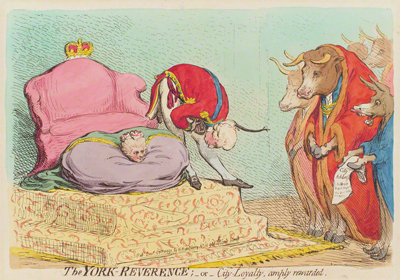The York Reverence, or City Loyalty, Amply Rewarded
This is one of the more bizarre-looking Gillray prints, and one can be forgiven for thinking it appears simply silly. But that, in fact, may be part of the point.
The context was this: Prince Frederick, the Duke of York, had done what none of his brothers had dared to do—marry a woman (Princess Frederica Charlotte of Prussia) with his parent's full permission and approval. Needless to say there was jubilation within the Royal Family but not only there. The country had grown weary of princely bad debts and worse behavior with the likes of Mrs. Fitzherbert, Mrs. Jordan, and Lady Tyrconnel. So the public was primed to pay their respects to, and celebrate every appearance of, the newly and properly wed couple.

© National Portrait Gallery, London
Among the early and most fulsome tributes to the Duke and Duchess of York were those from a delegation from the City of London. In the Evening Mail, for December 19th 1791, nearly an entire column is taken up with an address from the Lord Mayor, Aldermen, and Commons of the City of London to His Royal Highness, Frederick Duke of York followed by a similar address from the Lord Mayor etc. to Her Royal Highness, the Duchess of York. In each case, the address is then followed by an equally formal response from the Duke and Duchess expressing their gratitude.
The over-elaborate bow from the Duke and the curtsy from the Duchess so low as to seem to submerge her beneath the floor are, I take it, the visual equivalents of such silly and obseqious language. And the delivery of the City address by a braying donkey would seem to speak for itself.
But the Mayor and Aldermen as bulls with prominent horns may require further explanation. At least as far back as the Elizabethan era, London "Cits" had been satirized for their preoccupation with money and advancement at the expense of everything else including the chastity of their wives. But Restoration comedy seems to have made the connection between cits, horns, and cuckoldry even stronger such that The London Cuckolds 1682), a play by Edward Ravenscroft, is said to have been performed annually for many years on the Lord Mayor's Day. Thus the presence of the horned bulls and the donkey (whose ears look like horns) helps to establish that this is indeed a delegation from the City of London. But Gillray may be suggesting that receiving congratulations on their marriage from a collection of cuckolds might not, in fact, be the greatest honor shown to the royal couple.
Sources and Reading
- Commentary from the British Museum on The York Reverence. . .
- "Prince Frederick, Duke of York and Albany," Wikipedia
- "Princess Frederica Charlotte of Prussia," Wikipedia
- Thomas Wright and R.H. Evans, Historical and Descriptive Account of the Caricatures of James Gillray #63
Comments & Corrections
NOTE: Comments and/or corrections are always appreciated. To make that easier, I have included a form below that you can use. I promise never to share any of the info provided without your express permission.